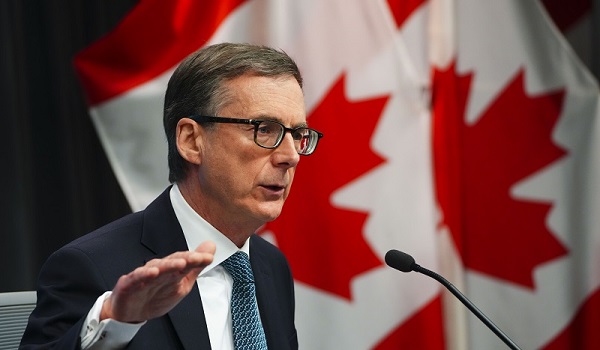Sequence of Bank of Canada rate hikes
The Bank of Canada has rapidly raised interest rates to five per cent over the past year and a half, starting from a low of 0.25 per cent in March 2022.
Inflation now appears to be trending downward and the economy is showing signs of slowing, prompting many economist to predict that the rate hiking cycle may be coming to an end – though the Bank of Canada hasn’t ruled out future hikes, and has given no indication of when it will cut rates.
Economists are largely expecting the central bank will hold rates at five per cent at this Wednesday’s rate decision. Here is a timeline of the rate decisions that got us here.
March 2, 2022: After leaving its overnight lending rate at 0.25 per cent for two years during the COVID-19 pandemic, the Bank of Canada raised interest rates 25 basis points to 0.50 per cent. The decision to raise rates came from rising inflation amid higher oil and commodity prices related to Russia’s sudden invasion of Ukraine.
April 13, 2022: A 50-basis-points hike brought the overnight lending rate to one per cent. This particular rate hike came with the notice that the Bank of Canada would soon begin quantitative tightening – meaning it would either sell or allow for its government bond holdings to mature, reducing the amount of money available to the financial markets. Meanwhile, the Russia-Ukraine conflict intensified, causing inflation to climb through increased energy prices.
June 1, 2022: A 50-basis-point hiked brought overnight lending rate to rise to 1.50 per cent. The Bank of Canada said the decision came after Canadian inflation reached 6.8 per cent in April, well above the bank’s target rate. The central bank anticipated inflation would rise even further due to excess demand within the Canadian economy, as well as rising food and energy costs.
July 13, 2022: The Bank of Canada raised rates by 100 basis points to 2.50 per cent —the largest single rate hike in more than two decades. The central bank predicted inflation would remain at around eight per cent for the next several months.
Sept. 7, 2022: This Bank of Canada raised its key rate by 75 basis points, bringing the overnight lending rate to 3.25 per cent. The central bank also continued with its quantitative tightening measures. It said geopolitical tensions, weakened demand from China and a tight Canadian labour market would continue to fuel inflation, as businesses struggled with labour shortages. It also warned that rates would need to rise further, with inflation still above target at 7.6 per cent.
October 26, 2022: The Bank of Canada raised rates by another 50 basis points, bringing the overnight lending rate to 3.75 per cent. The central bank said Canada’s economy was demanding more in goods and services compared to the supply that was available, putting upward pressure on domestic inflation. Inflation persisted, though the central bank also said its recent string of rate hikes were beginning to show in the country’s receding housing activity and softening in household and business spending.
December 7, 2022: The central bank raised rates by another 50 basis points, bringing the overnight lending rate to 4.25 per cent – the highest since January 2008. The Bank of Canada pointed to Canada’s stronger-than-expected third-quarter gross domestic product and near-historic low unemployment as two data points that would keep inflation elevated into 2023.
January 25, 2023: The Bank of Canada raised rates yet again with a 25-basis-point increase, bringing its overnight lending rate to 4.50 per cent. This hike was smaller than previous rate increases, as the central bank stated inflation was coming down around the world. Even so, inflation hadn’t come close to the Bank of Canada’s two per cent target rate, coming in at 6.3 per cent in December 2022.
March 8, 2023: A moment of pause finally came for the Canadian interest rate environment. The Bank of Canada decided to keep rates on hold and left its overnight lending rate at 4.50 per cent. The central bank said Canadian economic growth stalled in the fourth quarter of last year, which was lower than it had anticipated. It forecasted that economic growth would continue to weaken in the coming quarters and this would cause inflation pressures to ease.
April 12, 2023: The Bank of Canada took a wait-and-see approach and held rates at 4.50 per cent again.
June 7 2023: After two consecutive pauses, the Bank of Canada hiked its overnight lending rate by 25 basis points to 4.75 per cent. The move was driven largely by an uptick in inflation to 4.4 per cent, the first increase in 10 months, as well as stronger-than-expected economic growth in the first quarter of the year. The bank was also cautious about an uptick in housing market activity.
July 12, 2023: Another 25-basis-point hike brought bank’s overnight lending rate to five per cent. The Bank of Canada pointed to the tight labour market and increased housing market activity as risks for further inflation.
September 6, 2023: The Bank of Canada held the overnight lending rate at five per cent. The central bank pointed to an overall easing in inflation, despite a reacceleration to 3.3 per cent in July. It also said there was evidence of easing excess demand in the economy. Despite those trends, the central bank said it would not hesitate to hike rates again if necessary.
October 25, 2023: The Bank of Canada will deliver its next interest rate decision. Economists are forecasting a rate hold after inflation came in at 3.8 per cent last month, weaker than the 4.0 per cent that was expected.

This article was reported by BNN Bloomberg
















